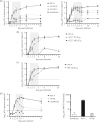Differential antiviral activities of respiratory syncytial virus (RSV) inhibitors in human airway epithelium
- PMID: 29596680
- PMCID: PMC6005027
- DOI: 10.1093/jac/dky089
Differential antiviral activities of respiratory syncytial virus (RSV) inhibitors in human airway epithelium
Abstract
Objectives: We report the use of reconstituted 3D human airway epithelium cells (HuAECs) of bronchial origin in an air-liquid interface to study respiratory syncytial virus (RSV) infection and to assess the efficacy of RSV inhibitors in (pre-)clinical development.
Methods: HuAECs were infected with RSV-A Long strain (0.01 CCID50/cell, where CCID50 represents 50% cell culture infectious dose in HEp2 cells) on the apical compartment of the culture. At the time of infection or at 1 or 3 days post-infection, selected inhibitors were added and refreshed daily on the basal compartment of the culture. Viral shedding was followed up by apical washes collected daily and quantifying viral RNA by RT-qPCR.
Results: RSV-A replicates efficiently in HuAECs and viral RNA is shed for weeks after infection. RSV infection reduces the ciliary beat frequency of the ciliated cells as of 4 days post-infection, with complete ciliary dyskinesia observed by day 10. Treatment with RSV fusion inhibitors resulted in an antiviral effect only when added at the time of infection. In contrast, the use of replication inhibitors (both nucleoside and non-nucleoside) elicited a marked antiviral effect even when the start of treatment was delayed until 1 day or even 3 days after infection. Levels of the inflammation marker RANTES (mRNA) increased ∼200-fold in infected, untreated cultures (at 3 weeks post-infection), but levels were comparable to those of uninfected cultures in the presence of PC786, an RSV replication inhibitor, suggesting that an efficient antiviral treatment might inhibit virus-induced inflammation in this model.
Conclusions: Overall, HuAECs offer a robust and physiologically relevant model to study RSV replication and to assess the efficacy of antiviral compounds.
Figures


Similar articles
-
Late therapeutic intervention with a respiratory syncytial virus L-protein polymerase inhibitor, PC786, on respiratory syncytial virus infection in human airway epithelium.Br J Pharmacol. 2018 Jun;175(12):2520-2534. doi: 10.1111/bph.14221. Epub 2018 May 2. Br J Pharmacol. 2018. PMID: 29579332 Free PMC article.
-
Preclinical Characterization of PC786, an Inhaled Small-Molecule Respiratory Syncytial Virus L Protein Polymerase Inhibitor.Antimicrob Agents Chemother. 2017 Aug 24;61(9):e00737-17. doi: 10.1128/AAC.00737-17. Print 2017 Sep. Antimicrob Agents Chemother. 2017. PMID: 28652242 Free PMC article.
-
Direct Inhibition of Cellular Fatty Acid Synthase Impairs Replication of Respiratory Syncytial Virus and Other Respiratory Viruses.PLoS One. 2015 Dec 11;10(12):e0144648. doi: 10.1371/journal.pone.0144648. eCollection 2015. PLoS One. 2015. PMID: 26659560 Free PMC article.
-
New antiviral approaches for respiratory syncytial virus and other mononegaviruses: Inhibiting the RNA polymerase.Antiviral Res. 2016 Oct;134:63-76. doi: 10.1016/j.antiviral.2016.08.006. Epub 2016 Aug 27. Antiviral Res. 2016. PMID: 27575793 Review.
-
Novel therapies for an old virus: treatment of RSV infections in the 21st Century.Expert Rev Anti Infect Ther. 2009 Nov;7(9):1125-9. doi: 10.1586/eri.09.90. Expert Rev Anti Infect Ther. 2009. PMID: 19883332 Review.
Cited by
-
Advances in development of antiviral strategies against respiratory syncytial virus.Acta Pharm Sin B. 2025 Apr;15(4):1752-1772. doi: 10.1016/j.apsb.2025.02.015. Epub 2025 Feb 20. Acta Pharm Sin B. 2025. PMID: 40486844 Free PMC article. Review.
-
Discovery of a Novel Respiratory Syncytial Virus Replication Inhibitor.Antimicrob Agents Chemother. 2021 May 18;65(6):e02576-20. doi: 10.1128/AAC.02576-20. Print 2021 May 18. Antimicrob Agents Chemother. 2021. PMID: 33782012 Free PMC article.
-
A model of respiratory syncytial virus (RSV) infection of infants in newborn lambs.Cell Tissue Res. 2020 May;380(2):313-324. doi: 10.1007/s00441-020-03213-w. Epub 2020 Apr 29. Cell Tissue Res. 2020. PMID: 32347384 Free PMC article. Review.
-
Safety and Antiviral Effects of Nebulized PC786 in a Respiratory Syncytial Virus Challenge Study.J Infect Dis. 2022 Jun 15;225(12):2087-2096. doi: 10.1093/infdis/jiaa716. J Infect Dis. 2022. PMID: 33216113 Free PMC article. Clinical Trial.
-
Bioengineering tools to speed up the discovery and preclinical testing of vaccines for SARS-CoV-2 and therapeutic agents for COVID-19.Theranostics. 2020 May 27;10(16):7034-7052. doi: 10.7150/thno.47406. eCollection 2020. Theranostics. 2020. PMID: 32641977 Free PMC article. Review.
References
-
- American Academy of Pediatrics. Updated guidance for palivizumab prophylaxis among infants and young children at increased risk of hospitalization for respiratory syncytial virus infection. Pediatrics 2014; 134: 415–20. - PubMed
Publication types
MeSH terms
Substances
Grants and funding
LinkOut - more resources
Full Text Sources
Other Literature Sources

